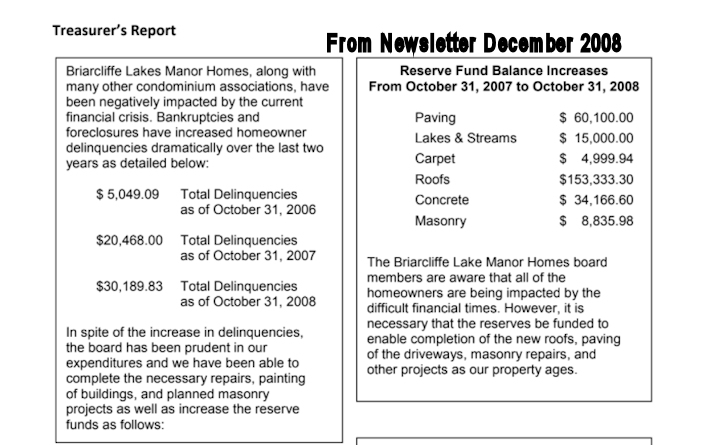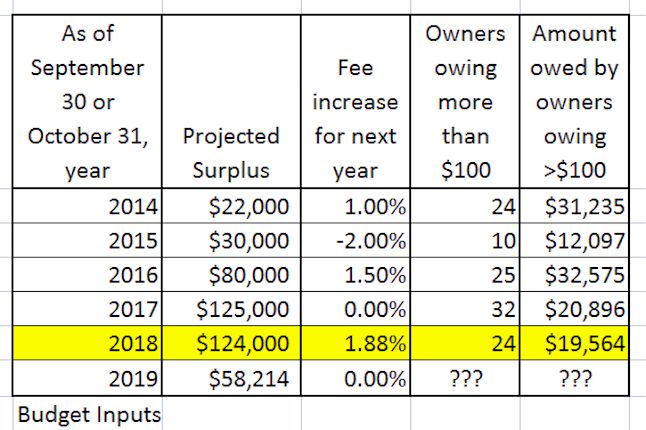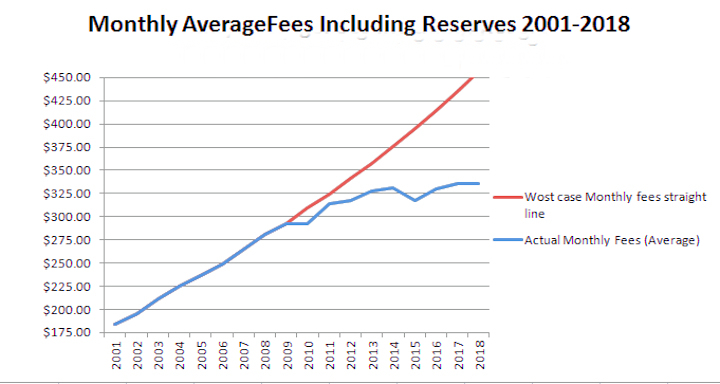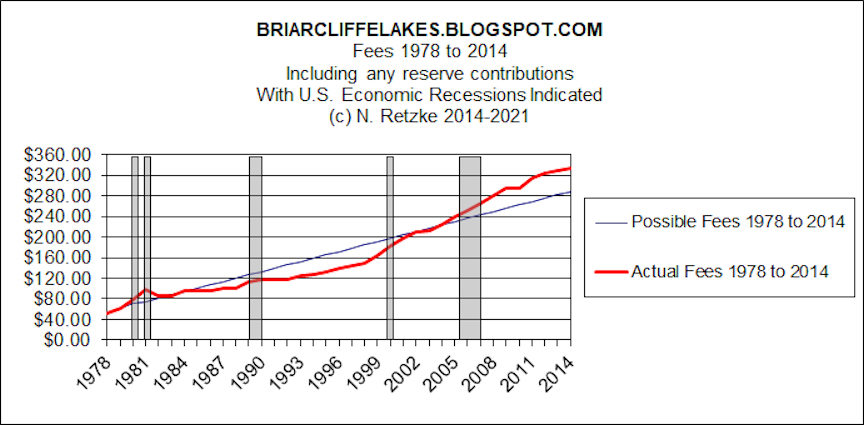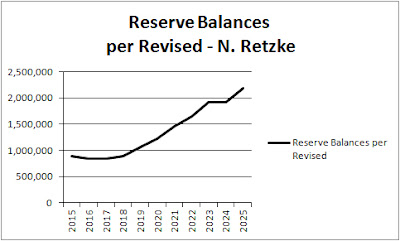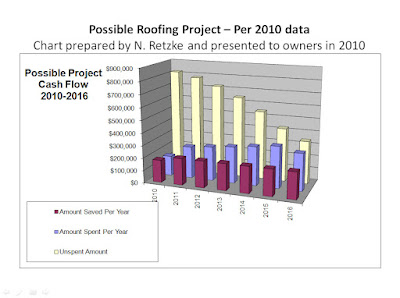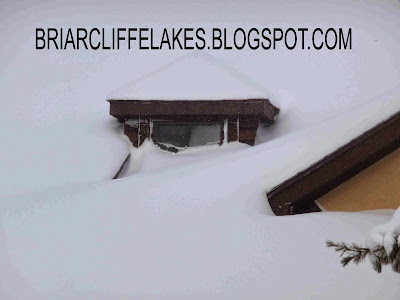
I'm in the process of purging files, etc. and of course I'm going through folders to figure out what to toss. Actually seven large "Banker's Boxes" of stuff, plus the hard drives. While doing this I'm re-discovering some interesting things.
This is
Part One of a two-Part post about Reserve Expenditures and it focuses on some of the details of the roofing project. I expect to post additional insights about finances in the near future. I chose this review of the roofing project because it represents a microcosm of the Association. It is a good example of what I encountered here at BLMH, the culture of this Association and of boards, and also what had to be done to overcome numerous obstacles in order to complete this project in a timely manner.
The project was begun by an earlier board. Three sequential boards were involved, as were at least four Architecture & Maintenance directors. The project duration was 12 years, plus an additional two years for completion of drainage issues. I completed 85% of the roofs in six years.
My research indicates that this association had a history of very low reserves and low annual reserve contributions. This changed with the roofing project. Here are some statistics. Monthly dollar amounts are average amounts per owner:
- From 1991 to 1998 fees increased an average of 3.0% per year.
- From 1999 to 2009 the fees increased an average of 7.2% per year.
- In 2001 the amount per owner contributed to reserves was less than $27.00 each month.
- In 2014 the amount per owner contributed to reserves was more than $111.00 each month.
- In 2001 the Association budgeted reserve contribution increased to about $108,000.
- In 2012 the Association budgeted reserve contribution was about $440,000.
- As fees increased, so did the reserves. In 2005, the year that the roofing project began the budgeted contribution to reserves reached $185,000; the highest to date over the previous 27 years of the association. But that amount paled compared to what was to come. The 2005 contribution to reserves was less than 50% of the peak amounts for reserve contributions, reached in 2011-2012.
- As fee increases continued, more and more was allocated each year to reserves.
- The reserve balances continued to increase, peaking at about $1,300,000 in 2014, but about 40% of the roofs remained to be done, and our major thoroughfare, Lakecliffe Drive, had failed prematurely and was replaced in 2014-2015.
- As of September 2018 the reserve balance was about $700,000 and is expected to increase thereafter. This is on target, per the work done by the financial committee in 2015. See the chart later in this post.
- The roofing project began in 2005 and fee increases greater than 5% per year continued for five more years.
The history of reserve contributions is not readily apparent to owners because boards did not provide separate statistics on the reserves. After observing Association operations from 2002 to 2008 it became apparent to me that the emphasis was meeting the Operations & Maintenance budgets. Meeting those annual, out of pocket expenses were the main thrust of the earlier boards. The reserves were called a "Replacement Fund" with rough categories. The Welcome Packets included a table of annual fee percentage increases from 1978 to the present. There was no history of reserve amounts and annual reserve contribution amounts. A prospective owner was give the Association financials which included the Budget and Balance Sheet. Owners were given a simple snapshot which included the current amount in reserves and the amount allocated for the current fiscal year. I'm sure that what was provided did meet legal requirements.
Here's a chart constructed in 2015 as we neared the end of the roofing project. The "flat" reserve balances predicted for 2015-2018 were a consequence of all of the projects expected to be completed in those years. It included a projection of completing other significant capital projects which were in the "backlog" of delayed projects:
 |
| Projected Reserve Balances 2015 and beyond - 2015 data |
According to documents the roofing project began in 2005, was paused and resumed in 2009. Apparently, the pause was to allow reserve balances to grow, although no board member openly stated that, to my knowledge. However, the delay also meant that roofs would wait and continue to age. The decision to delay and do roofs at a slow pace was probably a financial decision, but it didn't accommodate the age of the roofs, as the reader will see.
When the roofing project resumed, one roof was 18 years old (end of life). Fifteen were between 14 and 18 years old, and so on.
The roofing project would ultimately cost our owners about $2 million in fees. It became apparent there was a financial problem when looking at the reserve balances leading up to this project and the amounts allocated to the "roofs" each year in the "Replacement Fund". From 2002-2009 I wasn't made aware of the details as an owner. I never saw a board discussion during a meeting in which the total cost of the project was discussed in the presence of owners. Nor am I aware of a public discussion of how the board would achieve the reserves required for the project. I don't recall anything in the Newsletter regarding the full scope, financial magnitude and timeline of the project. The boards prior to 2009 were clever and discrete. It seems the board decided that there was no need for the owners to be made aware of the true situation. No one wanted to give bad news and boards intended to be re-elected. That worked until 2008.
In 2008 a small group of organized owners decided to take over the board. Interesting to me, the existing board, now under attack, suddenly discovered how to communicate the current financial situation about the roof and driveway projects. A privately funded letter went to all of the owners via US Mail. It was insufficient to convince owners and most of the board was replaced by a new board.
The roofing project was an expensive one which defined this Association for 16 years, absorbing nearly half of all of the reserve money collected during that period. Fees collected for
all reserves rose from less than $100,000 per year in 1998 to a peak of $440,000 in 2012; the project was completed in 2016. I once stated to earlier management and board that the large, annual fee increases to accommodate this project were in my opinion a "stealth" special assessment. For years the roofing project displaced other, necessary capital projects because it absorbed, or was expected to absorb, every last reserve dollar collected. From 2002 onward the board delayed other projects, only doing what was unavoidable. In doing so the board created a sizeable backlog of work, which future boards would have to complete and collect the funds to complete. Those future boards found themselves in a financial trap. It was a terrible spiral, where fees went up, but work wasn't done. That required additional fee increases. The board of 2009 thought they had enough money and voted on a 0% fee increase for 2010. They discovered the full magnitude of the problem in 2010 with an independent reserve study. The budget for the 2011 year included yet another large fee increase. That year it was 7%. That new board began planning significant repairs in the fall of 2008 but within two years discovered the financial realities of the Association.
By 2010 my burning question became "How to complete the roofs in a timely manner and eliminate the large backlog of other projects and maintenance?" This was one of the legacies of the earlier boards and it was left to others including myself to solve. The earlier boards had hamstrung, undermined and burdened those that followed. Owners paid the consequences, in many ways.
One consequence is the difficulty of attracting talent to the board. That is in part because of the earlier board culture, which persists today. Some board members don't want others on the board and take steps to make life difficult for new board members. They can't deal with some aspects of reality, preferring to be surrounded by "yes men" and "yes women". New board members are frequently unequipped to deal with adversarial board members and cliques or with the realities of the work required in a large and aging Association. There remains the echo of owners wounded by the 2008 financial crisis and the arrogance of earlier boards, such as the one that began the roofing project. On the surface, all looks well, but that surface appearance is very deceptive. Owners simply don't want to be targets on the board, or the headaches. It is difficult simply to do the work. Politics and personal agendas don't belong. So those who do volunteer may find themselves to be scapegoats, targets, and even mal-treated by other board members. There is also the possibility of personal agendas. Not everyone joins a board to work. As for the entrenched board members, well, they'll do everything and anything they can to retain power.
I've stated that while there were tangible benefits and new roofs were necessary, I did wonder if the scope and approach of the roofing project was appropriate at the time, considering the overall condition of the Association and the state of reserves and fees commencing in 2000. Certainly boards were aware of this impending project. One of the board members has been on the board for decades as President, Treasurer and so on. Adding a second layer of shingles to roofs had begun in 1991. That approach did have its limitations, as any capable roofer can attest. However, there had never been a formal reserve study until the new board of 2008 commissioned one in 2010, and that study created such confusion it was necessary for another in 2011.
The roofing project had been underway for six years.
I was the clean-up guy when I joined the board in 2010. I really didn't have much of a choice, but to continue the project. Considering the personalities of the various boards and the status of this "pet" project, there was no possibility of change. There was absolutely no question or discussion about completing this project. It would be done.
I simply had to figure out how to complete it, and a lot of other things, too, while not breaking the bank accounts of the owners. I saw a need to stabilize fees. An earlier board planned and began this project while avoiding a reserve study. For about a decade other projects and capital improvements were given short shrift while fees were collected and saved. Some things were done on the cheap, other things were ignored.
The streets were replaced in 2002-2003, but in an inferior manner and with no engineering and limited supervision; one began failing within four years. Unit concrete patio repairs were suspended. Timber retaining walls were rotting. Water main repairs were accomplished with "band aids", two streams had serious problems, all three pump pits were failing, common area decks needed major repair or replacement, driveways were aging, deck piers sunken in streams were rotting and the decks sinking, the condition of 84 garage floors was unknown, etc. Operations and Maintenance money was spent on painting, panel and trim, and Landscaping. The board attitude was "If it isn't broken don't fix it" and "Only do what was absolutely necessary". Arguing against hallway work, a board member who presided over the beginnings of the roofing project made the statement "We only replace [hallway] carpeting when it becomes a trip hazard". That was the prevailing attitude as money was accumulated for the roofing project.
Special landscaping continued but reserve fund expenditures were limited to mulch, entry beautification and tree removal as the EAB took its toll on the ash trees and old willows began falling. Some shore work was done on the North lake. Appearances were kept up. But there were serious problems, and some board members were aware of the issues, but denied responsibility. One prior board president privately acknowledged this with the comment "You can paint a pig, but it is still a pig".
It seemed some of the board members understood the issue, but were unwilling or unable to do anything about it, beyond continuously raising fees. I argued that no matter what the fees, the boards would spend every dollar collected. The sky was apparently the limit. There was always an emphasis on "No Special Assessments" but large, continuous fee increases were okay (almost 7% each year for a decade). I encountered boards in which some board members were entrenched and absolutely committed to continuous fee increases, no matter what the consequences for owners. One even stated during budget discussions that she/he "didn't care about the consequences of fee increases on owners." With the "Great Recession" of 2008 there were significant delinquencies and foreclosures to deal with. These things put added pressure on Association finances and owners.
It was a constant struggle, with what appeared to be almost insurmountable problems. When I pushed for other, vital and necessary capital repairs, one board member complained "Norm is spending all of the money". I am convinced that some board members failed to comprehend the magnitude of the problems, while others chose not to. There was palpable fear. Owners were struggling. From 2008 to the present several cliques were formed and votes were cast along "agenda" lines. Not the way an association should be run, but as we are all unpaid volunteers, I guess it could be said that owners get what they pay for. One board leader stated that "We [the board] should not cater to the lowest common denominator" during a discussion of setting the annual budget and the impact of continuous increases on owners. All of the spreadsheets, studies and projections could not dissuade this position. By 2015 voting became a personal endeavor, where negative votes were construed in the clique as a personal attack. This is the primary reason I decided to leave the board in the fall of 2018.
Enough is enough.
The next part of this post will look more closely into the roofing project.
NOTES:
- The 2017 fee increase was 1.5%. That year the Association had a budget surplus of $51,035 as of 12/31/2017. Is that significant? Had the fees been 4.08% lower we would have had a balanced budget. In other words, the fee increase of 2017 was unnecessary. That was my position when we were making that budget in October-November of 2016. As a "compromise" the board agreed upon a 1.5% increase. As of September, 2018 a budget surplus was projected for 12/31/2018; the actual surplus or deficit remains to be seen, and only after all 2018 bills are in. We had a 0% fee increase in 2018, and that board decision was accomplished because of the surplus of 2017. It became impossible for the "We need higher fees" promoter on the board to win that argument in the fall of 2017 because of the budget surplus of the prior year. Better budgeting yields better results, and that means better decisions are possible.
- I was involved on the board from September 2010 through September 27, 2018. During my tenure average annual fee increases were 2.0%. That was a result of board actions during that period. My 1,100 hours each year were spent well. More on this in a later post.
- The question owners don't ask, and even some board members don't ask, is this: "Where does the "budget surplus" money go?" Board members really should know the answer, and I can guarantee that all don't know the answer to this question.
- I became aware of a clique of current and former board members, run by our Association's most senior board member. After numerous attempts to sabotage or undermine other board members I reluctantly concluded there were both current and former board members who should not be trusted. Beware being "thrown under the bus".
- The following links to the "official" 2018 budget, which shows the 2017 budget, approved 2018 budget and the "projected" 2018 year end as of September 2018. In 2018 the treasurer and I asked management to provide several budget updates during the year, as part of our drive for tighter and ultimately better and more accurate budgets. "Better" budgets I define as 1) more useful and 2) less likely to result in poor decisions:
